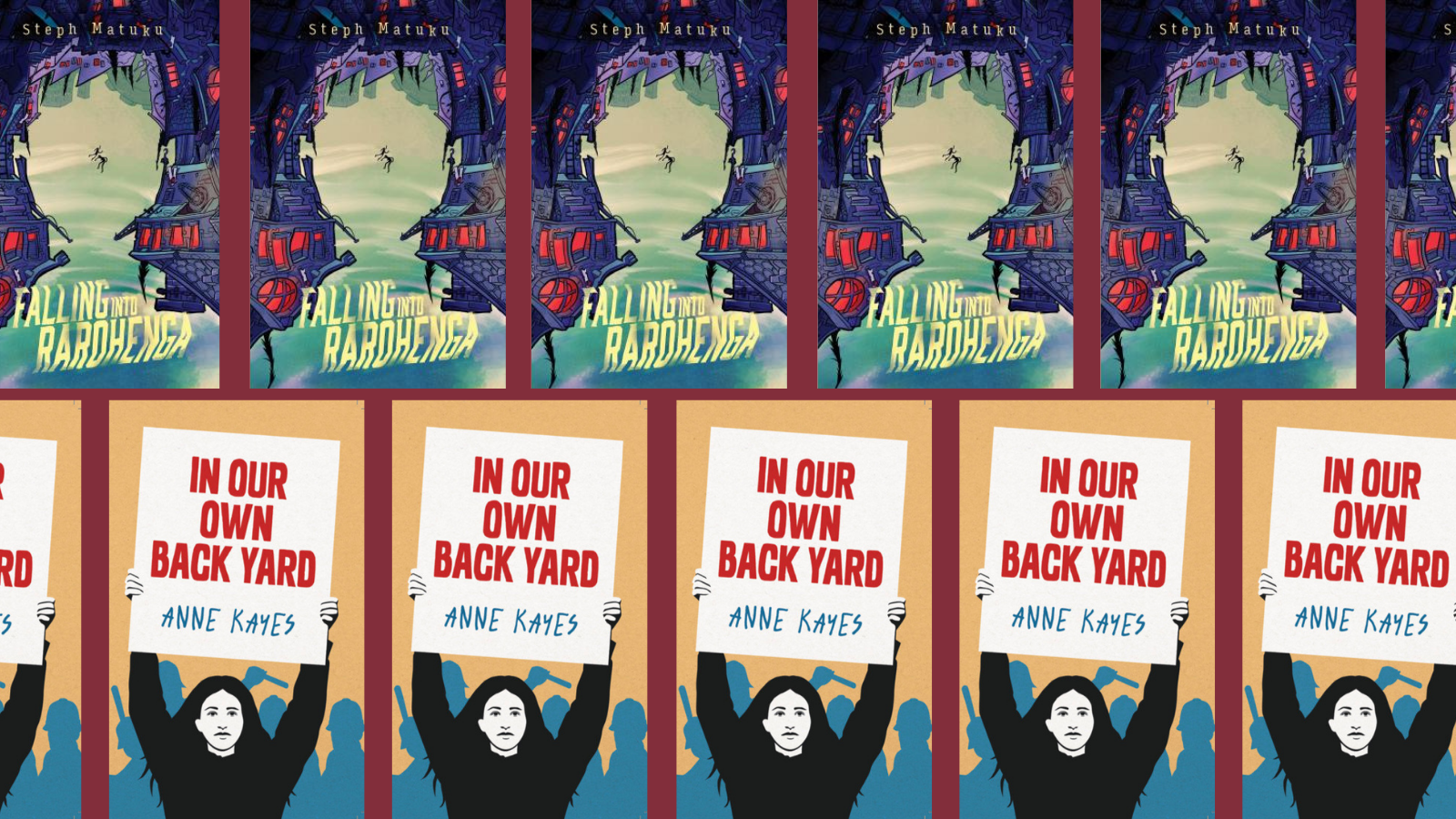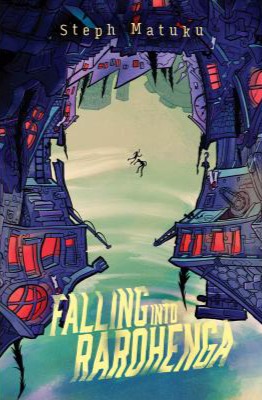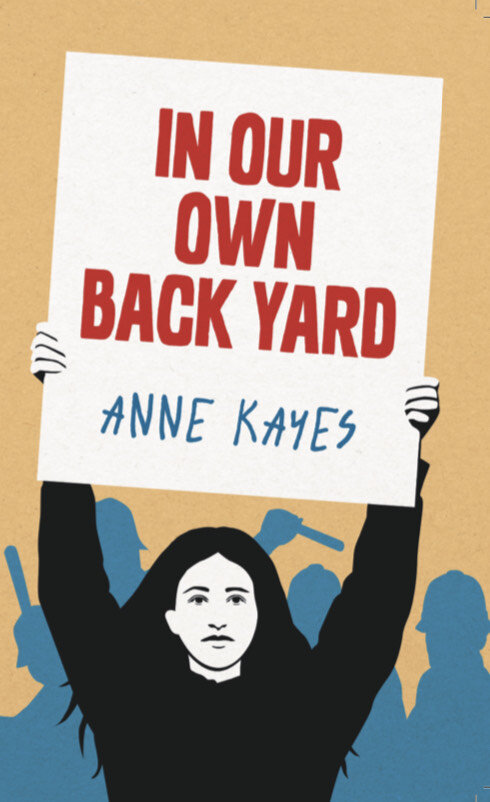It must be new young adult fiction season, because we’re back with more reckons on recent releases. Today, Tihema Baker talks two titles: Steph Matuku’s new fantasy novel Falling Into Rarohenga and Anne Kayes’ simultaneously contemporary and historical story In Our Own Back Yard.

Falling into Rarohenga by Steph Matuku (Huia Publishing)
I graduated from university with a degree in Māori Studies and English Literature—an unlikely combination that tends to be met with a raised eyebrow or two. Throughout my studies these worlds very rarely converged; one of the closest examples was probably finding a rare narrative about the death of Māui while researching Rarohenga, considered to be a Māori ‘underworld’. How I wish I’d found a book like Falling into Rarohenga back then—not only because it would have been a great resource for artistic interpretations of Rarohenga, but because it’s also just a bloody fun read.
Falling into Rarohenga is about teenage twins, Tui and Kae, who are sucked into the Māori underworld to save their mother. It’s one hell of a ride, following the twins from one challenge to the next, whether it’s making deals with treacherous tūrehu, mind-melding with taniwha, or standing up to powerful atua. That was the real delight of this novel for me; seeing so many elements of Māori mythologies come together, including many that I wasn’t familiar with. These representations feel true to their origins and therefore appropriately dangerous, while striking a nice balance with their comedic potential. Toilet jokes are usually low-hanging fruit but there’s something hilariously fitting about mighty Tāwhiri-mātea, atua of winds and storms, posing a legitimate threat with his god-tier farts.
That was the real delight of this novel for me; seeing so many elements of Māori mythologies come together, including many that I wasn’t familiar with.
Speaking of comedy, Falling into Rarohenga is genuinely funny. Tui and Kae are excellent foils for each other, and the alternating points of view in their narration utilise this dynamic to great comedic effect. Both get ample chance to really shine as heroes in their own light, then be taken down a notch by their sibling in the very next chapter. It makes for an authentic relationship too, which is crucial because, at its heart, this is a classic tale of a duo having to set aside their differences and work together to succeed. There’s a genuine love and respect between the two that must emerge in order for them to triumph, but it’s always tempered—whether by that snarky humour or the twins’ insistence on reminding each other of just how human they are.
In this way, Falling into Rarohenga manages to avoid, or at least only dabble in, many cliches it could have easily fallen into. At first glance, Tui is the typical straight-A, Hermione Granger of the duo, and Kae is the oafish, brawn-over-brains brother. But as the novel progresses, we learn that Tui is selfless but lonely, while Kae longs for his father and finds solace in music. There’s just enough depth to make these characters and their relationship feel believable without straying into melodrama. There’s a realness to them—as teenagers, and as Māori teenagers at that.
There’s a realness to them—as teenagers, and as Māori teenagers at that.
Perhaps this is the novel’s true success: its quintessentially Māori nature. This is obvious in its depiction of a place like Rarohenga, but it’s also there in the characters and their dialogue. It was refreshing to read something that isn’t yet another examination of the trauma and mamae that seem to dominate the Māori literary scene. There are hints of that to be found, but for me Falling into Rarohenga was all about a fun ride, inspired by the narratives that have shaped our people’s understanding of the world. There is so much there to celebrate and learn from—for Māori and Pākehā teens alike. All I have left to say is: more please.

In Our Own Back Yard by Anne Kayes (Bateman)
There’s a scene towards the end of In Our Own Back Yard that kind of sums up the danger of writing about racial issues from white perspectives. At the height of protest against the Springbok Tour of 1981, 15-year-old narrator Liza—a Pākehā—sits with her best friend, Rewi—a Māori. Liza is coming to terms with an emotionally distressing decision about her boyfriend. Rewi has just had his arm broken after being bludgeoned by a policeman. The scene ends with Liza in tears and Rewi comforting her from his hospital bed.
So a Māori teenager, who has spent the entire novel being racially profiled by police who stake out his house daily, now a victim of police brutality, ends up having to provide emotional support to a Pākehā teenager with boy problems. It’s a familiar trap that, despite what I’m certain are the author’s best intentions, this novel about reflecting on racism ‘in our own backyard’ ultimately falls into: centring white experiences.
In Our Own Back Yard is told in two different timelines: one in 2020, where a grown-up Liza and her family grapple with COVID-19 lockdown; the other in 1981, where a teenage Liza navigates school life and her first boyfriend amid the backdrop of the Springbok Tour. It’s a clever way of creating relevance in events that will be a distant history for contemporary teenage readers, by viewing them through the lens of a shared experience as seminal as the COVID-19 lockdown. I did wonder whether lockdown was the best way of doing this, when the murder of George Floyd and subsequent Black Lives Matter protests seem like the obvious, far more effective parallel to draw. The 2020 timeline does eventually touch on the movement, but it seemed like a missed opportunity—and perhaps the first hint that the novel might miss the mark on its exploration of racism in Aotearoa.
It’s a clever way of creating relevance in events that will be a distant history for contemporary teenage readers, by viewing them through the lens of a shared experience as seminal as the COVID-19 lockdown.
For the most part, the novel does a great job of avoiding this risk. Protagonist Liza is, first and foremost, simply a teenage girl dealing with annoying siblings, school, and falling in love. There’s a sub-plot told through her reading of The Taming of the Shrew about possessive men in hetero relationships, which becomes more relevant as her own relationship develops. It’s standard-fare YA stuff, but it’s complicated by the ever-present influence of the Springbok Tour on everyone in Liza’s life.
This is where the real heart of the novel lies; Liza witnessing and processing the racism that the tour unleashes in Aotearoa. Through her eyes we see the abuse hurled by skinheads, pro-tour rugby fans, and the police at her friends—like Rewi and his whānau who are closely involved in the protests, or Tongan friend Kalāsia who still has nightmares about the Dawn Raids. These moments feel authentically plucked from lived experience but, importantly, only observed by Liza, not appropriated. The most affecting are the descriptions of the protests at their most violent. Author Anne Kayes mentions in her acknowledgements that she drew on many resources covering the protests and it shows. These scenes are visceral, giving a strong sense of the frenzied violence that took place, and I was pleased that they often paid tribute to real-life figures who were there, like Merata Mita.
Liza tends to react to these events in ways that I hoped she, as a Pākehā protagonist, would: by allying herself with her non-white friends, or reflecting on how she could have spoken up for them when she didn’t. A common theme throughout is Liza finding the strength of her own voice.
This is why it’s such a shame where she ends up with Rewi. It would have been the perfect way to close a novel about racial injustice; for Liza to realise that, no matter how deeply she feels about the tour’s effects on her relationships or schoolwork, there’s a far greater story being told here. One that’s not actually about her. This is such a crucial lesson—for her, and for teenage readers.
There’s a far greater story being told here. One that’s not actually about her. This is such a crucial lesson—for her, and for teenage readers.
That said, the purpose of this review is not to re-write the novel to what I wished it to be, but to review it as it is. To that end, In Our Own Back Yard is a solid YA novel exploring racial injustice in a way that’s accessible to contemporary teenage readers. I can see it being a useful text to teach for secondary school English, which I’d go so far as to suggest it’s partially intended for. While promoting reflection on the racism that exists in our own backyard, however, it just risks misunderstanding the same lesson it sets out to teach.


Tihema Baker
Tihema Baker is a Māori writer of Te Āti Awa ki Whakarongotai, Ngāti Raukawa te Au ki te Tonga, and Ngāti Toa Rangatira. He is the author of YA novels Watchedand Exceptional, and has completed a Master of Arts in Creative Writing at Te Herenga Waka—Victoria University of Wellington’s International Institute of Modern Letters.



